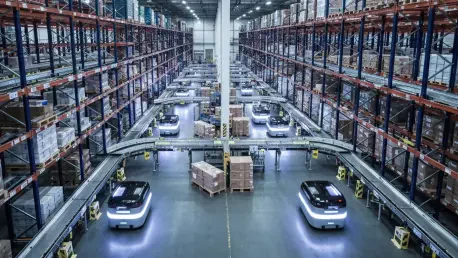Setting the Stage for a Logistics Revolution
In the fast-paced world of logistics and warehousing, efficiency is the ultimate currency, and the stakes have never been higher with global e-commerce sales continuing to soar to unprecedented levels. Amid this surging demand, a transformative technology has emerged as a game-changer: Autonomous Mobile Robots (AMRs). These intelligent machines are redefining how warehouses operate, tackling labor shortages and skyrocketing consumer expectations with unparalleled precision. This review dives deep into the capabilities of AMRs, exploring their core technologies, real-world impact, and the challenges they face in reshaping the logistics landscape. The focus is on understanding how these robots are not just tools but strategic assets driving operational excellence in an increasingly competitive market.
Core Technologies Powering AMRs
Artificial Intelligence and Data Optimization
At the heart of AMRs lies artificial intelligence, a cornerstone that enables these robots to process vast amounts of operational data for smarter decision-making. AI algorithms analyze patterns in warehouse workflows, optimizing tasks such as picking and sorting to achieve measurable gains in productivity, often boosting efficiency by significant margins. This data-driven approach ensures that every movement and action is calculated for maximum output, transforming raw information into actionable insights.
Beyond basic optimization, AI in AMRs facilitates real-time adjustments, such as dynamic route planning to avoid bottlenecks during peak hours. This capability is critical in environments where speed and accuracy directly impact customer satisfaction. Companies leveraging these systems report not only faster order fulfillment but also reduced operational costs, highlighting AI’s role as a pivotal force in modern logistics automation.
Navigation and Safety Mechanisms
Equally vital to AMR functionality are advanced navigation systems that allow seamless movement through complex warehouse layouts. Equipped with sensors and mapping technologies, these robots can detect obstacles, adapt to changing environments, and ensure safe interactions with human workers. Such features are indispensable in dynamic settings where unexpected barriers or layout shifts are commonplace.
The precision of obstacle detection enhances safety by minimizing collision risks, a critical factor in maintaining uninterrupted operations. Real-world deployments demonstrate how these systems enable AMRs to navigate crowded spaces without incident, ensuring both efficiency and worker well-being. This adaptability underscores the robots’ ability to integrate into existing infrastructures without necessitating major overhauls.
Industry Trends and Innovations
The AMR landscape is evolving rapidly, with innovations like incremental AI adoption gaining traction among logistics firms. Rather than overhauling entire systems, companies are applying targeted AI enhancements—often referred to as small, impactful updates—to address specific pain points. This approach allows for quick wins, building confidence in automation while keeping implementation risks low.
Another notable trend is the rise of Robotics-as-a-Service (RaaS) models, which lower the barrier to entry for businesses hesitant about upfront costs. By offering AMRs on a subscription basis, providers ensure clients can scale usage based on demand, focusing on outcomes rather than technical complexities. This shift reflects a broader industry move toward flexible, service-oriented solutions that prioritize accessibility.
Additionally, the push for automation is fueled by persistent labor challenges, with AMRs stepping in to fill gaps in workforce availability. As competition intensifies, staying ahead means embracing these technologies to maintain throughput and customer responsiveness. The trend points to a future where automation is not just an option but a necessity for survival in logistics.
Real-World Applications and Impact
AMRs are proving their worth across diverse industries, with warehousing and e-commerce at the forefront of adoption. In large-scale distribution centers, these robots streamline order fulfillment by autonomously transporting goods, slashing processing times dramatically. Their ability to operate around the clock offers a distinct advantage in meeting tight delivery schedules.
Specific implementations, such as those by leading robotics firms, showcase AMRs managing thousands of picks daily across multiple sites. These deployments highlight unique benefits like real-time workflow adjustments, ensuring orders are prioritized based on urgency. Such responsiveness directly enhances customer service, setting new standards for reliability in logistics.
Beyond efficiency, AMRs contribute to labor flexibility by taking on repetitive tasks, allowing human workers to focus on higher-value roles. This synergy between technology and manpower creates a balanced ecosystem where productivity and employee satisfaction coexist. The impact is clear: businesses gain a competitive edge while fostering a more adaptive workforce.
Challenges Hindering Wider Adoption
Despite their promise, AMRs face significant hurdles in achieving widespread adoption, starting with technical integration into existing systems. Ensuring seamless compatibility with diverse warehouse setups requires substantial customization, often leading to delays and unforeseen complexities. This challenge is compounded by the need for explainable AI, where decision-making processes must be transparent to build trust.
Regulatory and safety concerns also pose barriers, as accountability for autonomous actions remains a gray area. Governments and industry bodies are still grappling with standards for robot-human interactions, creating uncertainty for companies looking to scale deployments. Navigating this landscape demands careful planning to avoid potential liabilities or operational setbacks.
Market resistance, driven by high initial costs and organizational inertia, further slows progress. Many firms hesitate to invest without guaranteed returns, while others lack the internal expertise to manage such technologies. Addressing these issues through phased implementations and clear ROI demonstrations is crucial to overcoming skepticism and fostering broader acceptance.
Future Trajectory of AMRs
Looking ahead, the potential for AMRs to achieve full warehouse autonomy is on the horizon, promising a paradigm shift in logistics operations. Advancements in AI, such as pixel-level environmental analysis, could enable robots to interpret surroundings with unprecedented detail, further enhancing decision-making accuracy. This trajectory suggests a future where entire facilities operate with minimal human intervention.
The long-term impact extends beyond warehousing, with implications for manufacturing and retail sectors seeking scalable automation solutions. As AMRs become more sophisticated, their ability to handle diverse tasks—from inventory management to last-mile delivery—could redefine supply chain dynamics. This evolution will likely drive cost reductions and efficiency gains across industries.
Strategic development approaches, like layering capabilities over time, will be key to realizing this vision. By building on incremental successes, companies can mitigate risks while preparing for more complex applications. The journey toward comprehensive automation, though challenging, holds transformative potential for operational scalability and excellence.
Reflecting on the AMR Journey
Looking back, the exploration of Autonomous Mobile Robots reveals a technology that has already begun to reshape logistics with remarkable efficiency gains and innovative applications. Their core strengths in AI-driven optimization and advanced navigation have proven instrumental in addressing modern warehouse challenges. The real-world impact, from enhanced productivity to improved safety, underscores their value as indispensable assets.
Challenges such as technical integration and regulatory uncertainties have presented notable obstacles, yet the industry’s commitment to incremental progress offers a viable path forward. Moving ahead, stakeholders should prioritize strategic partnerships and phased adoption to balance innovation with practicality. Investing in training and transparent AI systems could further ease transitions, ensuring sustainable growth. Ultimately, the focus should remain on harnessing AMRs to build resilient, adaptable operations for a future defined by automation.









